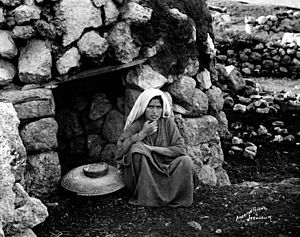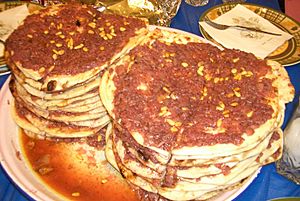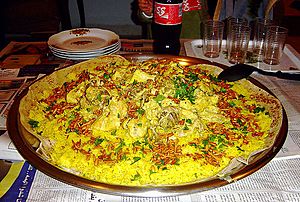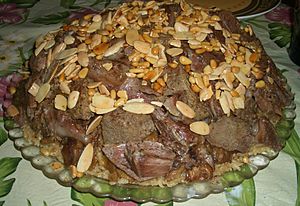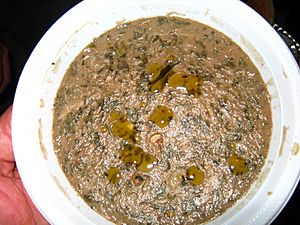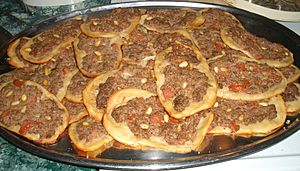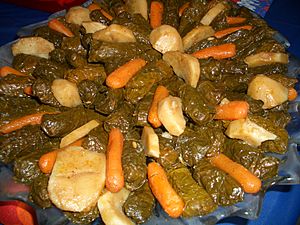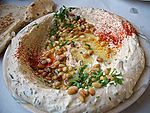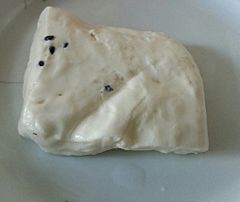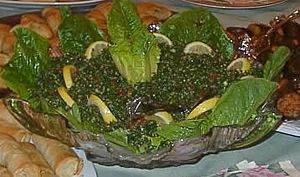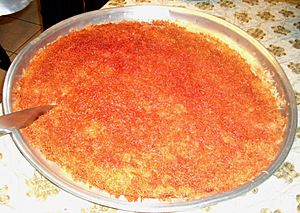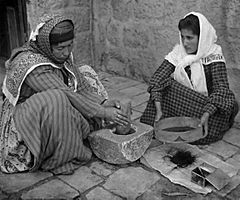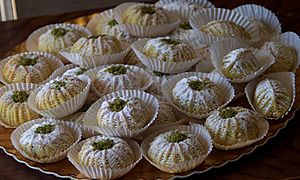Palestinian cuisine facts for kids
Palestinian cuisine includes the delicious foods eaten by people from Palestine, whether they live in Palestine, Israel, Jordan, refugee camps, or other parts of the world. This cooking style has been shaped by many different cultures over time. It started with Arab influences, then got ideas from Persian cooking, and later from Turkish food, especially during the Ottoman Empire. Palestinian food is quite similar to other foods from the Levant region, like Lebanese, Syrian, and Jordanian dishes.
The way food is cooked and the ingredients used often depend on the local climate and traditions. For example, in the Galilee area, rice and different kinds of kibbee (meat and bulgur dishes) are popular. In the West Bank, people enjoy heartier meals with taboon bread, rice, and meat. Along the coast, fish, seafood, and lentils are common. Gaza's food is also part of the Levant style but uses more seafood and spices, and people there love chili peppers! Meals are usually eaten at home, but going out to eat light meals like salads, dips, and grilled meats is becoming more popular for parties.
The region also has many sweet treats. Some are eaten regularly, while others are special for holidays. Most Palestinian sweets are pastries filled with sweet cheese, dates, or nuts like almonds, walnuts, or pistachios. Drinks can also be special for holidays, like during Ramadan, when carob, tamarind, and apricot juices are popular at sunset. Coffee is enjoyed all day. While not common for everyone, some traditional drinks like arak (an anise-flavored drink) or beer are consumed by Palestinian Christians.
Contents
How Palestinian Food Developed
The food in the southern Levant has a rich history, with many cultures adding their own flavors. When Muslims arrived in the 7th century CE, the area became part of a larger region called Bilad al-Sham. This is why Palestinian food, especially in the Galilee, is very similar to Syrian food. Modern Palestinian dishes have been greatly influenced by three main groups: the early Arabs, the Persian-influenced Arabs (from Iraq), and the Turks.
Early Arab cooking was simple, using rice, lamb, yogurt, and dates. This changed a lot when the Abbasid Caliphate, based in Baghdad, started adding Persian cooking styles to Arab food. A geographer named al-Muqaddasi, who lived in Jerusalem, wrote about Palestine's foods long ago. He mentioned olives, dried figs, raisins, and carob fruit. He also noted special cheeses and excellent apples from Jerusalem, and dates from other areas.
When the Ottoman Empire took over Palestine in 1516, their cuisine, which already included rich Arab dishes, became another big influence. Later, around the mid-1800s, people from Bosnia, Greece, France, and Italy settled in cities like Jerusalem and Bethlehem. Their cooking also added to the unique flavors of Palestinian cuisine, especially those from the Balkan region.
For a long time, especially in rural areas until the 1950s or 60s, the main ingredients for Palestinian cooking were olive oil, oregano, and bread baked in a special oven called a taboon. These ovens were often shared by several families and kept hot all the time.
Different Cooking Styles by Region
There are three main cooking regions in historical Palestine: Galilee, Gaza, and the West Bank. Each has its own special dishes. In the Galilee, bulgur and meat (beef or lamb) are key ingredients, often mixed to create various meals. In the West Bank and Gaza, people have their own unique styles. West Bank meals are often hearty, with rice, flatbreads, and roasted meats. Because Gaza is on the Mediterranean coast, fish is a main food. Gazan cooking also uses a lot of chili peppers, dill seeds, and garlic, influenced by Egyptian food. Even though each region has its own style, people often share and enjoy foods from other areas.
Galilee Cooking
The Galilee region's food is very similar to Lebanese cuisine because the two areas were closely connected for a long time. Galilee is famous for dishes made with bulgur, spices, and meat, known as kibbee.
- Kibbee bi-siniyee: This is minced lamb or beef mixed with spices like pepper and allspice, wrapped in a bulgur crust, and then baked. It can be the main dish for lunch.
- Kibbee neyee: A raw version of kibbee, mixed with bulgur and spices. It's usually a side dish, eaten by scooping it up with pita or markook bread. Leftovers are often cooked later, perhaps as fried kibbee balls.
Another common dish in Galilee is pilaf, a rice meal mixed with chopped lamb and pine nuts, seasoned with spices. It's often served with a lamb leg or whole chickens. Grilled meats on skewers, like shish kebab or lahme mashwi and shish taouk, are popular after a selection of small appetizers called mezze.
West Bank Dishes
Musakhan is a popular main dish from the northern West Bank. It's made with roasted chicken served over taboon bread, topped with fried sweet onions, sumac, allspice, and pine nuts. Maqluba means "upside-down" and is a rice and baked eggplant casserole. It's mixed with cooked cauliflower, carrots, and chicken or lamb. This dish is well-known across the Levant and has been around since the 13th century.
Mansaf is a traditional meal in the central and southern West Bank, with roots from the Bedouin people of Jordan. It's usually made for special events like holidays, weddings, or big gatherings. Mansaf features a lamb leg or large pieces of lamb served on taboon bread, often covered with yellow rice. A special thick, dried yogurt made from goat's milk, called jameed, is poured over the lamb and rice, giving it a unique flavor. The dish is garnished with cooked pine nuts and almonds. Traditionally, mansaf is eaten with the right hand.
Beyond main meals, many West Bank areas are known for their fruit jams. In Hebron, grapes are a main crop. Families harvest them to make raisins, jams, and a molasses called dibs. Bethlehem is famous for its apricots and apricot jam, while Tulkarm is known for its olives and olive oil.
Gazan Flavors
Gaza's food is influenced by nearby Egypt and its location on the Mediterranean Sea. Fish is a main food for most people there. Gaza has a big fishing industry, and fish is often grilled or fried after being stuffed with cilantro, garlic, red peppers, and cumin, and marinated with chopped lemons. Besides fish, Gazan cooking uses hot peppers, garlic, and chard to flavor many meals. Zibdieh is a clay pot dish with shrimp baked in a stew of olive oil, garlic, hot peppers, and peeled tomatoes. Crabs are cooked and then stuffed with a spicy red pepper paste called shatta.
A dish unique to Gaza is Sumaghiyyeh. It's made with water-soaked ground sumac mixed with tahina (sesame paste). This mixture is added to sliced chard, stewed beef pieces, and garbanzo beans, then flavored with dill seeds, garlic, and hot peppers. It's often eaten cool with khubz bread. Rummaniyya is a seasonal dish made with unripe pomegranate seeds, eggplant, tahina, garlic, hot peppers, and lentils. Fukharit adas is a slow-cooked lentil stew with red pepper flakes, crushed dill seeds, garlic, and cumin, usually made in winter and early spring.
Qidra is a rice dish named after the large clay pot and oven used to bake it. The rice is cooked with meat (often lamb), whole garlic cloves, garbanzo beans, cardamom, and spices like turmeric (which gives it a yellow color), cinnamon, allspice, nutmeg, and cumin. Plain rice cooked in meat or chicken broth with mild spices like cinnamon is called fatteh ghazzawiyyeh. This rice is layered over thin markook bread, covered in ghee (a type of butter), and topped with stuffed chicken or lamb. It's eaten with green peppers and lemon sauce.
Types of Meals
Bread and Pastries
Palestinians bake many kinds of breads: khubz, pita, markook, and taboon. Khubz is an everyday bread, similar to pita. It's often used instead of utensils; people tear off pieces to scoop up dips like hummus. Markook bread is very thin and almost see-through when unfolded. Taboon bread gets its name from the special ovens it's baked in.
There are also several sandwich and pizza-like foods:
- Manaeesh: A baked flatbread, usually topped with za'atar (a spice mix) and olive oil.
- Simboseh and fatayer: Baked or fried doughs filled with minced meat and cooked onions or pine nuts. Fatayer is often folded into triangles and can also be filled with spinach or za'atar.
- Sfiha: A small baked flatbread topped with lamb and cooked red peppers or tomatoes.
- Shawarma: Shaved lamb or chicken wrapped in a long khubz roll, with pickled turnips, cucumbers, tomatoes, onions, and tahina. It can also be served on a plate with tahina.
- Falafel: Fried patties made from fava beans or chickpeas, parsley, and onions. They are usually served wrapped in khubz.
Stuffed Vegetables (Mahashi)
Mahashi dishes are made from stuffed vegetables like eggplants, small pumpkins, potatoes, carrots, and marrows. They also include stuffed leaves, especially grape leaves, cabbage leaves, and sometimes chard. Making mahashi takes time and care, so it's often prepared the day before it's cooked. Many family members help with the rolling and stuffing.
Waraq al-'ainib (grape leaves), also known as dolma, is a mahashi meal for big gatherings. Grape leaves are usually wrapped around minced meat, white rice, and diced tomatoes, though sometimes meat isn't used. They are cooked and served as many rolls on a large plate, often with boiled potato slices, carrots, and lamb pieces. Kousa mahshi are zucchinis stuffed with similar ingredients and often served alongside waraq al-'ainib.
Dips and Side Dishes
Dips and side dishes like hummus, baba ghanoush, mutabbel, and labeneh are popular for breakfast and dinner.
- Hummus: The Arabic word for chickpeas. It's commonly made as hummus bi tahini. Chickpeas are soaked overnight, boiled, then mashed and mixed with tahini (sesame paste) and sometimes lemon juice. It's often topped with olive oil and sometimes sprinkled with paprika, oregano, and pine nuts. The town of Abu Ghosh near Jerusalem is famous for its hummus. Hummus can also be mixed with fava beans (ful) to make mukhluta, a different dish with a brownish color.
- Baba ghanoush: An eggplant dip with many variations. The main ingredients are broiled and mashed eggplant and tahini, topped with olive oil. It can be flavored with garlic, onions, peppers, cumin, mint, and parsley. Mutabbel is a spicier version with green chili peppers.
Jibneh Arabieh or jibneh baida is a white table cheese served with many dishes. Ackawi cheese is a common type of jibneh baida. It has a smoother texture and a mild salty taste. It comes from the city of Akka (Acre), which is why it's called Ackawi. Labaneh is a thick, yogurt-like cream cheese. It's served on a plate with olive oil and za'atar (called labeneh wa za'atar) or in a khubz sandwich.
Salads
Tabbouleh is a popular Mediterranean-style salad from the Levant. It's made from chopped parsley, bulgur, diced tomatoes, and cucumbers, dressed with lemon juice and vinegar. In 2006, the world's largest bowl of tabbouleh was made by Palestinian cooks in Ramallah. Fattoush is a salad with pieces of khubz bread, parsley, chopped cucumbers, radishes, tomatoes, and scallions, flavored with sumac. Dagga is a Gazan salad, usually made in a clay bowl, with crushed tomatoes, garlic, red hot peppers, chopped dill, and olive oil. It's seasoned with lemon juice just before serving.
Sweets
Palestinian desserts include baklawa, halawa, and kanafeh, as well as other pastries made from semolina and wheat.
- Baklawa: A pastry made of thin layers of dough, filled with pistachios and walnuts, sweetened with honey.
- Halawa: A block of sweetened sesame flour, served in slices.
- Muhalabiyeh: A rice pudding made with milk and topped with pistachios or almonds.
- Kanafeh: A very famous dessert from Nablus in the West Bank. It's made of fine pastry noodles with honey-sweetened cheese in the middle. The top layer is often dyed orange and sprinkled with crushed pistachios. Nablus is still known for its kanafeh because it uses a special white cheese called Nabulsi cheese. Boiled sugar syrup is poured over it.
Snack Foods
It's common for Palestinian hosts to offer fresh and dried fruits, nuts, seeds, and dates to their guests. Roasted and salted watermelon, squash, and sunflower seeds are popular, as are pistachios and cashews. Watermelon seeds, called bizir al-bateekh, are often eaten during relaxing activities like playing cards, talking with friends, or before and after meals.
How Meals are Structured
Food is a big part of Palestinian culture, whether it's an ordinary day or a special event like a wedding or holiday. Meals are usually eaten in a cycle throughout the day, with two main courses and several smaller ones, including coffee, fruits, and sweets. Like in many Arab cultures, meals are a time for family and can last 1–2 hours. Lunch is usually the biggest meal, while breakfast and dinner are lighter.
- Iftur (Breakfast): Usually includes fried eggs, olives, labaneh, olive oil, or jams. Hummus is also often eaten at this time.
- Gheda (Lunch): Usually eaten late in the afternoon. This is the heaviest meal of the day, with main ingredients like rice, lamb, chicken, cooked vegetables, and stuffed dishes (mahashi).
- Asrooneh (Afternoon Snack): Eaten after lunch, this includes a variety of fruits and legumes.
- Asha (Dinner): Usually eaten between 8-10 pm. Dinner is lighter than lunch, with foods like fatayer, hummus, various salads, and a Levantine-style omelette called ijee.
- Hilew (Sweets): Served sometimes after or before dinner, and when guests visit. Baklawa is common and often bought from pastry shops, while muhallabiyeh is usually made at home.
- Shay wa Kahwe (Tea and Coffee): Served throughout the day, before, after, and between meals.
Eating Out
- Mata'im (Restaurants): Offer a great selection of cold appetizers called mezze, like hummus, different eggplant salads, tabbouleh, fattoush, and chili pepper salads. Hot appetizers include kibbee balls and sfiha. Restaurants usually serve main dishes like shish kebab, shish taouk, rack of lamb, and chicken breasts.
- Al-Maqhah (Coffeehouses): Serve hot and cold drinks. These places are traditionally for male customers who enjoy playing cards or backgammon and smoking nargileh (hookah).
- Mahal 'hilewayet (Sweet Shops): Found in city markets, these shops offer many Palestinian sweets like kanafeh, baklawa, and anise-flavored cookies. Family-run shops often have their own unique sweet creations.
- Mahal falafel (Falafel Shops): Sandwich shops that mainly sell falafel and shawarma with different fillings.
Drinks
Palestinians enjoy two main hot drinks: coffee in the morning and throughout the day, and tea in the evening. Tea is often flavored with na'ana (mint) or maramiyyeh (sage). The coffee is usually Turkish or Arabic style. Arabic coffee is unsweetened but spiced with cardamom. Homemade fruit juices are popular on warm days and during Ramadan. A warm drink made from sweetened milk with salep (a type of flour) and topped with walnuts, coconut flakes, and cinnamon, called sahlab, is mainly served in winter.
Arak is a clear, anise-flavored drink popular among Palestinian Christians and some less strict Muslims. It's mixed with water, which makes it cloudy and creamy white. It's enjoyed during special events like holidays, weddings, or with mezze. Beer is also consumed, and the town of Taybeh in the West Bank has the only beer brewery in the Palestinian territories. They also make non-alcoholic beer. Soft drinks are common in Palestinian homes, with bottling and distribution centers in cities like Ramallah, Gaza, Hebron, and Nablus.
Holiday Foods
Palestinian food changes quite a bit between daily meals and special holiday meals, which include family and religious occasions for both Muslims and Christians.
Ramadan
During the fasting month of Ramadan, a person called a Musaher used to walk through towns, yelling and beating a drum to wake people up for suhoor (the meal before dawn). This meal, eaten very early in the morning, is light and includes labaneh, cheese, bread, and fried or boiled eggs, along with drinks. The call to dawn prayers signals the start of the fast.
Breaking the fast in the evening traditionally begins with dates and a chilled drink. Palestinians make various fruit-based drinks for this, like tamar hindi (tamarind), sous (licorice), kharroub (carob), and Qamar Eddine (apricot). Tamar hindi is made by soaking tamarinds in water, then straining, sweetening, and mixing with rose water and lemon juice. Kharroub is made similarly using carob. Qamar Eddine is made from dried apricots boiled into a liquid and chilled.
The evening meal to break the fast is called iftar. It starts with soup, often made from lentils, vegetables, or freekeh (cracked, green wheat cooked in chicken broth). Many different dishes are served for iftar, from small vegetable plates to large trays of meat. Common small dishes include bamia (okra in tomato paste), mloukhiyeh (a leafy green stew), or maqali (fried tomatoes, eggplants, potatoes, peppers, and zucchini). Pilaf or plain freekeh are usually served with the main meat dish. Families often prepare extra food to share with neighbors and those in need.
Holiday Sweets
A common Palestinian dessert made only for Ramadan is qatayef. You can find it from street vendors in many Palestinian cities or make it at home. Qatayef is the name for the whole dessert and also for the pancake-like batter used as its base. The batter is poured onto a hot plate, cooked on one side, then folded. It's filled with unsalted goat cheese or ground walnuts and cinnamon. Then it's baked and served with hot sugar syrup or honey.
Ka'ak bi 'awja is a semolina shortbread pastry filled with ground dates (called ajwa) or walnuts. This dessert is traditional for Christians during Easter. It's also prepared at the end of Ramadan to be eaten during Eid al-Fitr (a Muslim festival after Ramadan) and Eid al-Adha. During Mawlid, a holiday celebrating the birth of the Islamic prophet Muhammad, Zalabieh is served. These are small, crunchy, deep-fried dough balls dipped in syrup, made from flour, yeast, and water.
A special pudding called mughli is made when a new baby is born. It's made from ground rice, sugar, and spices, topped with almonds, pine nuts, and walnuts. When a baby gets its first tooth, it's celebrated with bowls of sweetened wheat or barley. Christian families in mourning serve a sweet bun called rahmeh. This food is eaten to remember the dead and bless their souls. The Greek Orthodox Church also offers a special tray with cooked wheat covered with sugar and candy after a memorial service.
See also
 In Spanish: Gastronomía de Palestina para niños
In Spanish: Gastronomía de Palestina para niños


